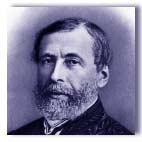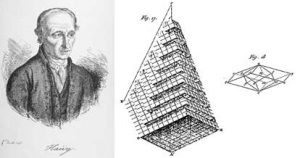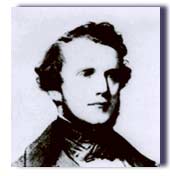FOUNDATION OF S.F.M.C.
The French Society of Mineralogy and Crystallography (Société Française de Minéralogie et de Cristallographie) was founded on March 21st, 1878. Monsieur DES CLOIZEAUX, professor at the Natural History Museum in Paris ( Muséum d’Histoire Naturelle), took the initative to gather several scientists at the Sorbonne, sending them the following letter (here translated from the French):
« Sir,
Some mineralogists conceived that it would be of interest to gather once a month to converse about the recent scientific achievements that may be of interest to mineralogy.
I thus have the honour to invite you to be on Thursday, March 21st, at the Sorbonne, salle des Actes, staircase n°3, at 5 pm.
Yours faithfully »
A. DES CLOIZEAUX
Out of 200 invited scientists, 43 replied to the invitation and straight away registered as full members of the Society.
Among those, were Mr. RICHARD, THOULET, FOUQUE et LEVY. The denomination of « Société Française de Minéralogie et de Cristallographie » was agreed upon by all, and despite some temporary changes since, this name remains unchanged since 1974.
INITIAL MOTIVES (after a text by Jean WYART )
It may be useful to consider the motives of those mineralogists that met in 1878, while they were already members of the French Geological Society (Société Géologique de France) that was founded in 1830 by some of those very people.
Mineralogy is a primordial science. In its largest acceptation, it was considered as the part of Natural Sciences that dealt with the mineral world, thus encompassing all of the Earth Sciences. Since the beginning of times, human beings used minerals for tools, building materials, ornaments. They became prospectors, minors, and acquired knowledge to find and dig out the mineral materials they needed. Mining activity, including hundreds of metres long drifts, is attested as far back as two thousand years ago in various parts of the world and is evidence for a profound knowledge of geology. Among the oldest documents, those of PLINUS the Elder, at the beginning of the Christian Era, of MARBODE, XIth century, and of AGRICOLA, at the beginning of the XVIth century, are entirely devoted to mineralogy.
However, until the end of the XVIIIth century, mineralogy only distinguished about fifty minerals constituting the Earth crust (and some of them actively sought after for their properties).
From a descriptive and practically oriented science, mineralogy evolved towards a rigorous science when René-Just HAÜY came up in 1781 with his theory on the structure of crystals. He invented crystallography, describing crystals by using geometrical measurements of dihedral angles between faces of crystals, as measured with a goniometer. He defined mineralogical species as « une collection de corps dont les molécules intégrantes sont semblables par leurs formes et composés des mêmes principes unis entre eux dans le même rapport », that is, in modern language, having building molecules (unit cells) of identical geometry, and made of the same (chemical) constituents in identical proportions. Using the goniometer, he could explain all the different morphologies displayed by a same mineral. He contributed the description of many new mineral species. At the same times, chemistry was developing rapidly and was also becoming a quantitative science through the use of the balance and the discoveries of LAVOISIER, PROUST, DALTON, or BERZELIUS, thus permitting precise chemical analyses of minerals.
René-Just HAÜY and an extract of his « Traité de Minéralogie » (1801) – Plate III, showing the stacking of the « molécules intégrantes » (concept of unit-cell) in a calcite crystal.
At the same times, chemistry was developing rapidely and was also becoming a quantitative science with the use of the balance, and the discoveries of LAVOISIER, PROUST, DALTON, or BERZELIUS, thus permiting precise chemical analyses of minerals.
Mineralogy was considerably enriched by the advances of crystallography and chemistry. However, HAÜY’s « hypothèse réticulaire » ( lattice hypothesis) was not unanymously accepted, and crystallographic calculus was putting off many mineralogists and chemists.
At the beginning of the XIXth century, a quarrel opposed HAÜY and BERZELIUS, who was rejecting HAÜY’s theories of crystallography, and considered that mineralogy was in itself a branch of chemistry, and could not have other grounds than chemical.
Crystallography progressed with DELAFOSSE and BRAVAIS. The use of optical crystallography to identify minerals, by DES CLOIZEAUX and others, also contributed to bring mineralogy from field work to laboratories.
This is the reason why some mineralogists and crystallographers came to found our Society in 1878…
THE END OF THE QUARREL BETWEEN NATURALISTS AND CRYSTALLOGRAPHERS
Mineralogy is at a cross-road between mathematics, physics, chemistry, natural sciences and cosmology. The scientists who founded our Society were divided into two « families »: first the naturalists and petrographers, led by FOUQUE, then by Alfred LACROIX; on the other side, crystallographers, such as MALLARD, WYROUBOFF and DUFET, and standing between these groups was DES CLOIZEAUX. It must be noted that the latter was not always successful in conciliating the different views. Crystallographers in the old days were more aggressive than the naturalists. Some of them displayed sharp dihedral angles, and sometimes used of such undistinguished terms in their manuscripts that these required minor corrections before publication…
Nevertheless, one of the fundamental characteristics of our Society was the cordiality that was the rule among its members, the senior members always being ready to help the beginners, and the latter always paying proper respect to their elders. Because Science does not need personal quarrels, we hope that this example from the SFMC founding fathers will always inspire modern mineralogists.
THE BULLETIN DE MINERALOGIE
At the first meeting of the Society, a commission was created to organise the publication of a monthly Bulletin. Its prime objective is « to establish a link between all those who are interested in the progress of Mineralogy and Crystallography ».
The first issue of the « Bulletin de Minéralogie » reflects the goal of the members of the Society to support an innovative and rigorous vision of mineralogy. The first communication is by HAUTEFEUILLE, and reports silica crystallisation by the dry method, reproducing quartz and trydimite. At these times, several chemists were concentrating their efforts on mineral syntheses by dry methods at high temperatures, and they were successful in reproducing a large number of crystals.
But the importance of these studies was fully revealed only as FOUQUE and LEVY succeeded in reproducing a large set of crystals naturally occurring in volcanic rocks. Experiments involving the genesis of crystals in the Earth interior are now common, and made easier by technological progress, but it was not the case in 1880. It is also around 1880 that pioneering work about isomorphism was published in the Bulletin. For instance, attention was brought on polymorphism by MALLARD, in a communication entitled « De l’action de la chaleur sur les substances cristallisées » (the action of heat on crystalline materials). Following these seminal publications, many others contributed to the renown of our Society.
The Bulletin de Minéralogie ceased publication in 1989. Along with the S.F.M.C., the D.M.G. (Deutsche Mineralogische Gesellschaft) and the S.I.M.P. (Società Italiana di Mineralogia e Petrologia) renounced to their national publications and launched the European Journal of Mineralogy.
The Bulletin de la Société minéralogique de France (1878-1885) and the Bulletin de la Société française de Minéralogie (1886-1948) are available online at Gallica website of the Bibliothèque nationale de France.






